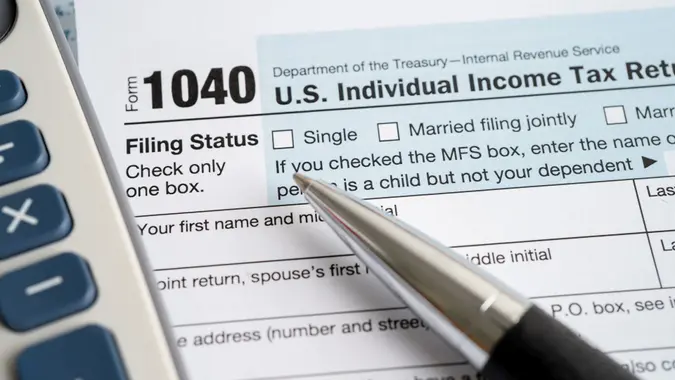How a 1035 Exchange Works and When to Use One

Commitment to Our Readers
GOBankingRates' editorial team is committed to bringing you unbiased reviews and information. We use data-driven methodologies to evaluate financial products and services - our reviews and ratings are not influenced by advertisers. You can read more about our editorial guidelines and our products and services review methodology.

20 Years
Helping You Live Richer

Reviewed
by Experts

Trusted by
Millions of Readers
A 1035 exchange allows a tax-free exchange of a life insurance policy, annuity contract, long-term care product or endowment for another of a similar structure.
This means that any gains or losses from the previous contract aren’t recognized by the IRS and no taxes are assessed when moving the cash value of one contract to another.
A 1035 exchange is a useful financial planning tool to help people move from one insurance contract to another without triggering additional tax liabilities.
What Can Be Exchanged Under Section 1035?
The Internal Revenue Code (IRC section 1.1035-1) allows people to exchange one contract for another of a like kind. This means that a life insurance contract can be swapped for another life insurance contract, or an annuity contract can be traded for another annuity contract.
| Original Contract | Can Exchange To | Tax-Free? |
|---|---|---|
| Life Insurance | Life Insurance / Annuity / LTC | Yes |
| Non-Qualified Annuity | Annuity / LTC | Yes |
| Life Insurance | New policy with different insured | No |
| Annuity | Life Insurance | No |
| Cashed-out policy | New policy (funds received first) | No |
There is an exception for life insurance policies — they can be swapped for an endowment, annuity contract or long-term care policy. A nonqualified annuity, for example, can only be exchanged for another nonqualified annuity or a long-term care policy. This gives life insurance contract holders more flexibility when exchanging their policy.
When you perform a 1035 exchange, you must report the transaction using IRS Form 1099-R.
What Isn’t Allowed in a 1035 Exchange
Several things aren’t allowed in a 1035 exchange, including:
- Changing the Primary Insured Person: This means you can’t change the primary insured person on any policy and keep the tax-free status on your exchange.
- Exchanging an Annuity for a Life Insurance Policy: Doing this may result in paying taxes on gains within the annuity.
- Taking Receipt of Funds: You can’t cash out an existing policy and deposit funds in your bank account if the funds are used to purchase another policy.
When to Consider a 1035 Exchange
There are several scenarios where a 1035 exchange might be beneficial.
- Your current life insurance policy or annuity does not offer competitive rates
- Your financial goals have shifted — such as needing long-term care coverage as you age
However, it’s important to weigh the potential disadvantages. Some new policies might come with surrender charges or specific conditions that weren’t present in your previous contract, affecting the overall benefits you receive.
Pros and Cons of Using a 1035 Exchange
While a 1035 exchange gives you flexibility, it’s not always the best idea. Here are a few pros and cons of using a 1035 exchange:
Pros
- Avoid Taxes: The primary benefit of a 1035 exchange is saving on taxes when exchanging one policy for another.
- Better Contract Terms: A 1035 exchange lets you out of a contract into one with more favorable terms and possibly better investment options.
- Additional Coverage: If you need more coverage, a 1035 exchange lets you pick a policy that fits your needs without paying additional taxes.
- Change Companies: A 1035 exchange lets you change insurers to one you prefer.
Cons
- May Pay Surrender Fees: Many insurance contracts and annuities have surrender charges when exchanging your policy.
- Commissions on New Policy: You may pay commissions on a new policy, reducing your accumulated cash value.
- Contestability Period: If you’re exchanging a life insurance contract, the new policy may have a contestability period where the insurance company could be absolved from paying out in certain instances for the first few years of the policy.
- May Still Owe Tax: Depending on your policy, you may still face expenses, like paying taxes on an old policy’s outstanding loans.
- Higher Premiums: If your health has declined, you may pay more for a policy than you previously had with the old contract.
Should You Do a 1035 Exchange?
A 1035 exchange can be a great way to help you update your insurance or annuity coverages without the penalty of paying taxes on gains within the previous policy. You can avoid losing money to additional taxes while picking a policy that better suits your needs.
But it’s important to consider your total financial picture when considering a 1035 exchange and ensure you understand any possible consequences of giving up your old policy.
Since this process can be complicated, it’s a good idea to work with a tax professional to ensure you complete it according to IRS regulations.
FAQs
- What are the requirements for a 1035 exchange?
- The new policy must be the same as the old one regarding insured parties and payout structures. The exchange has to be direct without taking possession of funds.
- Can I exchange an annuity for long-term care insurance?
- Yes, a nonqualified annuity can be exchanged for long-term care insurance during a 1035 exchange without facing tax consequences, providing more flexibility in planning.
- Will my premiums increase after a 1035 exchange?
- Your premiums might increase if your health has declined since your original policy or the new policy terms differ, so evaluate costs before proceeding.
Our in-house research team and on-site financial experts work together to create content that’s accurate, impartial, and up to date. We fact-check every single statistic, quote and fact using trusted primary resources to make sure the information we provide is correct. You can learn more about GOBankingRates’ processes and standards in our editorial policy.
- IRS. 2024. "Line-by-Line Help Free File Fillable Forms."
- IRS. 2024. "2024 Instructions for Forms 1099-R and 5498."
 Written by
Written by  Edited by
Edited by 

























